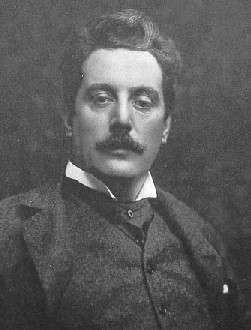A full time researcher in university and an amateur art commentator, Cheong obtained his master’s degree in Public Policy at Willy Brandt School of Public Policy at the University of Erfurt and is formerly a clarinettist of the Erfurt Philharmonic Orchestra in Germany. He loves classical music and now serves as conductor of the orchestra in Escola Choi Nong Chi Tai, by which he can connect art to everyday life. Cheong is also a book lover.

Portrait of Giacomo Puccini
A few months ago, I have the privilege of watching Turnadot, the opening gala opera, at the 30th Macao International Music Festival. As Puccini’s final opera piece, Turnadot has an underlying theme of fate. Although Puccini never managed to finish the work in his lifetime, the suspense contained in this piece of work has prompted the audience to reflect on the meaning of the work itself. Indeed, the audience can pen his or her own ending to the story, an artistic process that gives the observer an active role in experiencing and interpreting the work. In the performance, Rudy Park starred as the male tenor, Calaf, whose immensely rich, soul-searching voice stunned the audience. Equally impressive was the performance of the National Chorus of Korea: an incredibly touching performance marked by excellent articulation, expressive musicality and sense of harmony. In addition, Lana Kos, who starred as Liu, was magnificent with her singing of Quel Nome. Her performance translated Liu’s value for love into music, and brought to life the character so willing to sacrifice herself in her unrequited love.
Adopting the ending by Franco Alfano, the third scene in which Liu protects her lover with her own blood culminates in a dramatic and touching moment. Her sacrifice for love and noble ideals reveal the great expectations and hope for love in Puccini’s world. Such an ending is quite typical for such works. In the narrative, Calaf moves Turnadot’s heart, and the two lovers decide to tie the knot. The story captures the purity and perfection of humanity, ideals that are truly worth pursuing.
On the other hand, Luciano Berio’s ending, penned in 2002, offers a more elusive ending of suspense. That ending simply reveals the break of day, at which point Turnadot is all by himself, so that there is no hint as to what will follow. Nevertheless, one may guess that Turnadot is alienated from his family and friends. The choice of interlude music reflects Turnadot’s subtle changes in emotions, and the use of contemporary music elements highlights the different effects of the chorus, presenting artistic breakthroughs aligned with Puccini’s preferences towards music styles.
It will be difficult to compare and rate the two endings. On the contrary, both creative works are faithful to Puccini’s wishes, with their respective merit. Certainly, Alfano’s ending is more akin to fairytales, and may appear unrealistic. However, Pandora’s box has realised the concept of hope in people’s lives. I believe that despite the unrealistic nature of the fairytale ending, it is justified to portray hope as an important element in life. It may sound somewhat cliché, but it also has a grain of truth.
In the performance, one can tell that the organiser is supportive of local arts groups and artists, as it has commissioned a number of local musicians to be the guest musicians. At the same time, local actors are given the opportunity to perform. The performance of these homegrown artists would benefit from more practices and training to meet international standards, however, it is essential to give these artists ample opportunities to participate and showcase their work, so that they can improve further. Perhaps they will not star in the major roles at the beginning, but provided that they work hard and make the best of their roles onstage, the audience will definitely be discerning to notice their efforts. For example, in the second scene when the three ministers—Ping, Pang and Pong—made their exit, the servant could be seen pushing the box along, and his steps are synchronised with the background music. Such harmony between music and dramatic gesture becomes a musical dialogue between the cast and the audience. In this way, even though they are not the main characters in the show, the fine details of their acting will leave a strong impression and, in time, prepare them for significant roles.